NauticalNotebook.com
© 2010-
Please contact us with any questions or comments

Shore Excursion Review: Falkirk Wheel and the Antonine Wall
Edinburgh, Scotland
July 7, 2009
By Neil Plotnick
Looking through the shore excursion brochure several months prior to taking a cruise is a regular ritual in our family. Most of the time, we try to find outings that appeal to every one of us. However our port call in Edinburgh, Scotland was different. While my wife and son opted for a tour of the famous Ediburgh Castle, I was intrigued by the description of the Falkirk Wheel. Opened in 2002, it is reportedly the world’s only rotating boatlift, and connects the Union Canal and Forth & Clyde Canal, which are roughly 115 feet apart. Being transported while riding a canal boat in a gigantic Ferris wheel sounded unique and exciting. Lisa had no interest in what sounded like a scary carnival ride; I relished the idea of witnessing a prime example of modern, Scottish engineering.
Our motorcoach picked us up at the dock and we were entertained by a lovely woman
whose accent was certainly not native to Scotland. Born in America, she had lived
in the United Kingdom with her husband for many years. She made sure that we learned
that our American pronunciation of Pitts-
The scenery in Scotland is stunning. Endless green hills and valleys, some dotted with farms, gave a peaceful feeling to our tour. As we neared Falkirk, the largest structure I saw was the soccer stadium that is home to FC Falkirk, a member of the Scottish Football League. A shop keeper I met later told me. “The boys lost in the league final this past year but we love them.”
Falkirk is approximately halfway between Edinburgh and Glasgow. A series of canals and locks built in the 1930s connected the two cities and passed through Falkirk. Falling into disuse, various British and Scottish ministries decided to reconnect the cities and create a dramatic solution to what had originally required the transit of 11 distinct locks with the world’s first and only rotating boat lift.
Pulling into the futuristic visitor center it is impossible to ignore the Falkirk Wheel. Dominating the skyline, it resembles a highway overpass that seemingly comes to an abrupt stop with the roadway suspended over the lake at the base of the structure. Just outside of the visitors center was a tourist information center. I initially assumed that it was part of the Falkirk Wheel complex but it was actually a small gift shop with information on Falkirk and the surrounding area. I picked up a calendar and some free brochures and walked the short distance to the Falkirk Wheel visitors’ center.
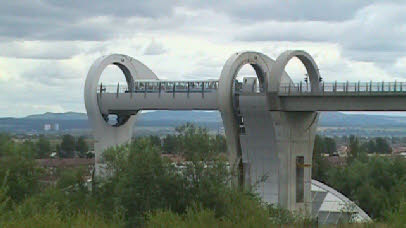
The bright and modern visitors’ center is a great place to learn about the history
and design of the Falkirk Wheel. 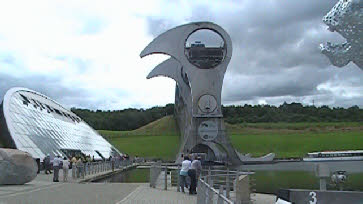 There were a number of competing designs that were
proposed to accomplish the challenging task of lowering and raising boats a tremendous
vertical distance in a very small area. Touting the long history of innovative Scottish
engineering, (I could not help thinking of Commander Montgomery Scott on the Starship
Enterprise), the visitor center had a number of interactive displays explaining the
physics and engineering behind the winning design. There was an extensive gift shop
with the requisite fridge magnets, postcards, shirts and books for sale. Prices were
reasonable and I purchased a few items to take home.
There were a number of competing designs that were
proposed to accomplish the challenging task of lowering and raising boats a tremendous
vertical distance in a very small area. Touting the long history of innovative Scottish
engineering, (I could not help thinking of Commander Montgomery Scott on the Starship
Enterprise), the visitor center had a number of interactive displays explaining the
physics and engineering behind the winning design. There was an extensive gift shop
with the requisite fridge magnets, postcards, shirts and books for sale. Prices were
reasonable and I purchased a few items to take home.
After spending some time exploring the exhibits, we were directed outside to board the canal boat Archimedes and start the exciting portion of our tour. A photographer was on hand to snap your photo in front of the canal boat for purchase at the end of the tour. Once on board, we were given an extensive explanation of the process we were about to experience firsthand. Accompanying the live lecture, television screens throughout the boat showed historical photos of the older lock system and helped illustrate the rotating boat lift.
With a gentle push from the motor, Archimedes sailed from the lake into the open end of the boat lift. Once secured in the lift, a door was closed behind the boat effectively sealing us in. Directly above, a second lift was filled with water and simultaneously sealed at one end. The two chambers were exquisitely balanced and only a small amount of energy was required to rotate the chambers and switch their positions. Our guide said that the balance was precise; the amount of electricity expended was equivalent to what was needed to boil six kettles of water.
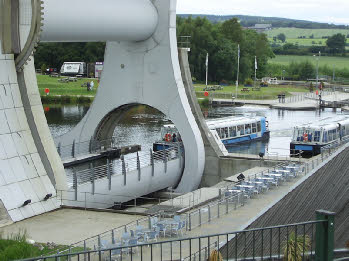
The entire process was incredibly smooth and quiet. During the movement, it was fun to watch the gigantic gears and guide wheels move as we slowly were lifted to the canal high above our original position. The sensation of movement was almost imperceptible and most of us aboard took the opportunity to admire the view as more of the Scottish countryside came into view. The entire process takes about six minutes to change elevation. Once the wheel reached the top position, the front door opened up and we sailed out approximately 100 feet higher than from where we began.
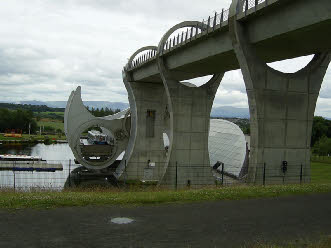
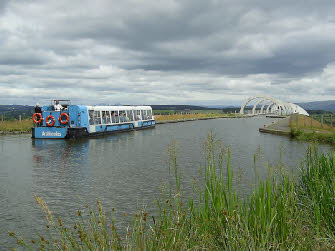
We then sailed a short distance down a canal and under a tunnel. The tunnel was constructed to pass under the remains of Roman Fortifications built nearly 2,000 years ago. After passing through the tunnel, the operator moored the canal boat and allowed passengers to debark and explore the Antonine Wall. We were cautioned that the walk to and from the Antonine Wall was about one mile over uneven ground. Some passengers decided to remain aboard and simply repeat the process to return to the visitor’s center. Most of us got off and were rewarded later with the opportunity to view the wheel in operation from above.
The Antonine Wall marked the northern frontier of the Roman Empire in the British Isles. The remains near the Falkirk Wheel are not nearly as impressive or complete as the more famous Hadrian’s Wall further south. Our guide gave us each a map and several markers were available that detailed the type of fortifications that previously stood on the site. The Romans used natural barriers whenever possible and it was easy to see where hilltops and deep ridges were exploited to create defenses. A series of deep ditches were reconstructed near the trail to show how simple trenches could be used to slow down advancing soldiers. Each ditch was about two feet wide and four feet long. With a number of these ditches lined up together, the land near the trail resembled an emptied egg carton.

After spending about thirty minutes exploring the wall area, our group began the descent back to the visitors’ center down below. It was fascinating to watch the Falkirk Wheel in action. Not only were the dedicated canal boats in action, but several small pleasure craft were also using the wheel and nearby conventional locks to traverse this portion of Scotland. This was a great opportunity to take in the bucolic countryside and witness the wheel in action from a variety of viewpoints as we walked. There are extensive trails in the area so ambitious visitors can enjoy a great variety of plants and trees that surround the waterway.
Once we returned to the visitor center, we were given ample time to shop for souvenirs and tour the nearby sculptures that surrounded the Falkirk Wheel. Some passengers sat down in the inside café or examined the exhibits, I walked around and discovered that an ice cream shop was open. I grabbed a cone and watched as a small pleasure craft navigated some conventional locks that were just below the Falkirk Wheel basin. It is always exciting to see simple and elegant engineering solutions to problems in action.
We boarded our motorcoach and began our trip back to our ship. Along the way, our roadway paralleled a canal with additional locks for a portion of the trip. I am certain that the original builders would have been pleased to know that their work was still being used nearly 80 years later. Our tour guide then gave us a wonderful surprise. It seemed that our coach driver was an accomplished photographer and had taken pictures of our trip on Archimedes. He passed around a clipboard and all interested passengers were asked to write down their email addresses. When we returned home, 17 photos were waiting in my inbox. Our driver managed to capture our passage from the base at the visitors’ center to the canal at the summit. He had climbed up the hill to follow our boat and the photos were indeed amazing.
During our return trip, our tour guide gave us detailed explanations of the various clans and Kingdoms that had fought in Scotland over the centuries. Along with the stories about famous people and royalty from the past, we learned that author J.K Rowling of Harry Potter fame did much of her early work in the Edinburgh area. As we approached Edinburgh, our guide made sure we looked at the harbor that we had left behind several hours earlier. Instead of seeing all the boats floating at their moorings, boats were resting on mud as most of the harbor water had exited with the tide.
Overall, this was an interesting and unusual shore excursion. There are ample opportunities to explore ancient ruins throughout the British Isles but it was certainly different to experience an engineering marvel constructed only a few years earlier. The Falkirk Wheel is a unique attraction and the surrounding countryside is certainly beautiful to see. Our trip to the British Isles and Ireland brought us to many historic sites but there are only so many castles and forts that I can visit before they all start to blur together. I thoroughly enjoyed experiencing firsthand an intriguing piece of modern engineering sited within a bucolic setting.
Edinburgh, Scotland
Falkirk Wheel and the Antonine Wall




